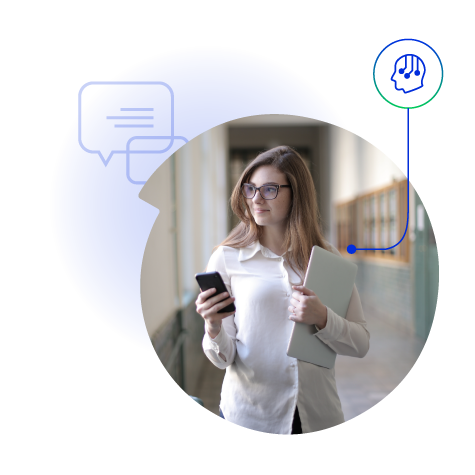Live webinar: Cut costs, grow revenue - Discover the new Comm100 AI trifecta ✨
Register nowLive webinar: Cut costs, grow revenue - Discover the new Comm100 AI trifecta ✨
Register nowIn the competitive world of higher education, providing students with the very best support is key to increasing enrollment, improving student satisfaction, and reducing drop-out. However, with the technological demands of students rising, it’s not always easy for schools to provide students with the level and quality of support that they expect – especially within a tight budget.
This is where chatbots for colleges and universities come into play. By automating student support, chatbots help schools deliver the support that their students expect, from immediate responses to 24/7 help. Higher ed chatbots are expanding the services available to prospective and current students alike, even while cutting costs. Better still, students are overwhelmingly open to using bots. In our student survey, 95% said they are at least somewhat open to receiving support from a higher ed chatbot.

In this guide, we’ll provide a comprehensive look at chatbots for colleges and universities, including:
We’ll begin with an explanation of what chatbots are, and how they can benefit colleges and universities.

Chatbots have seen tremendous growth in recent years, becoming one of the primary communication channels for support.
A chatbot is a software program that responds to student requests and holds conversations in a text interface. Typically embedded in live chat software on websites, website visitors can ask the chatbot questions and receive an immediate answer based on content and material that the bot has been trained on.
Chatbots for colleges and universities can also be used to gather valuable information from prospective students interested in learning more about your school, making them ideal for recruitment. Multilanguage support also allows chatbots to communicate in the student’s language of choice, allowing them to easily handle international requests in other time zones.
During non-peak periods, the additional support capacity that chatbots provide can deliver faster resolutions to student queries and reduced wait times. For requests handled entirely by chatbots, students see no wait times, as a single chatbot can respond to an unlimited number of simultaneous chats with no delay.
Now that we’ve explained how chatbots for colleges work, in the next chapter we’ll look more at the benefits of chatbots in higher education.

With our introduction to higher ed chatbots complete, in this chapter we’ll look more closely at the benefits of chatbots in education.
Chatbots for colleges and universities can play a major role in improving the agent experience by reducing monotonous work. By allowing a chatbot to handle the most time consuming and unrewarding work, agents can focus their time on more engaging questions and tasks. This in turn helps schools improve employee engagement and even reduce agent turnover.
Chatbots for colleges help support teams increase support capacity without growing in size. This is because chatbots can handle an unlimited number of requests at one time. In education, this means that schools can more easily scale up when support volumes peak during busy seasons such registration periods – all without having to hire and train temporary staff.
The popularity of live chat and chatbots among student demographic helps schools to increase engagement for both current and prospective students. While students may be put off from phoning a school, or even from the prospect of waiting days for a response on email, chatbots for universities are accessible, convenient, and fast – all factors that encourage students to connect.
Because a higher ed chatbot can handle an unlimited number of simultaneous chats, they allow support teams to maintain a high service level without the high support costs. A well-trained chatbot can handle more than 80% of a school’s incoming chats without human intervention, meaning that they’re ideal for high volume teams, handling the workload of many agents during peak periods.
Read more: Chatbot ROI calculator – Reduce support costs and scale your operations with AI Chatbots
Since a higher ed chatbot can handle most requests without intervention, it allows schools to offer 24/7 support in a cost-effective way. This is more important than ever for student support – our student survey found that 99% think it’s at least somewhat important for schools to offer 24/7 support. 58% of students think it’s very important. For schools, 24/7 support also means availability to other time zones for improved international recruitment and student support.


Book a 30-min, obligation-free demo with our chatbot specialist to understand how you could adopt a bot.

We’ve seen the benefits of chatbots in higher education, but there is more than one kind of chatbot. In this chapter, we’ll look at the types of chatbots for universities and colleges that are on the market, explaining what each can do and the situations that each is best suited for.
Task bots are a great first step into automation for those who are unfamiliar with the technology. Task bots can resolve queries by guiding the visitor through a series of questions and answers. Besides text responses, task bots can also reply to students using external links, images, and video to provide a more engaging and dynamic response.
Task bots can respond in a variety of ways to student queries, such as:
Like all types of chatbots for colleges, task bots can handle all these requests 24/7 to provide unparalleled support without the need to hire additional agents. Task bots are an ideal way for schools to boost international recruitment and provide better access to student services.
One of the key reasons that task bots are so popular among schools is their ease of setup. Through simple drag-and-drop templates, a basic task bot can be set up in a matter of minutes. We’ll look more at building a higher ed chatbot in chapter 5.
AI chatbots integrate artificial intelligence so that they can respond to more requests and complete more tasks in a more ‘human-like’ way. Rather than simply responding to keywords in requests, AI chatbots can understand the complexities of language, including student intent, escalating to a human agent when necessary. AI chatbots are also able to take action for a student to handle tasks like receiving payments for student fees.
Along with understanding student intents, an AI higher ed chatbot offers conditional logic so that every interaction can be based on the student’s profile. This could mean a unique response based on the kinds of programs that your students are enrolled in, or unique interactions for international students that offer support in a student’s native language through automatic chat translation.
Thanks to their advanced ability to understand student requests and respond accordingly, a Comm100 AI Chatbot can handle more than 80% of student requests without any human interaction. As Lachlan Todd, Communications & Systems Coordinator at Thompson Rivers University, explains:
“I don’t have a computer science or programming background so finding a chatbot that was simple to build and code-free was crucial – and Comm100 Chatbot delivered on this. With a little learning and guidance from Comm100’s bot architect team, I built our bot from scratch with no technical knowledge. I think anyone who has a social media account can build a Comm100 Chatbot.”
Read more: Thompson Rivers University adopts Comm100 Live Chat & Chatbot across 5 departments

Since today’s students have specific needs born out of Gen Z’s access to technology at an early age, it can be helpful to look at chatbot examples in higher ed to understand the various ways of universities using chatbots. In this chapter we’ll look at five of the top higher ed chatbot use cases. For even more inspiration, check out this free SlideShare:

Learn the top 10 chatbot use cases that universities and colleges around the world are benefitting from.
With a higher ed chatbot handling most common requests, agents have more time available for the complex and queries. This enables agents to give students attention when needed, providing the personalization and care that today’s students expect.
Especially when queries turn to more sensitive matters, universities using chatbots have a higher capacity to demonstrate care for mental health and well-being among students.
One of the top higher chatbot use cases involves the booking of appointments and on-campus services. In the context of a library, this could involve bookings for study rooms or equipment.
Gen Z are the fastest generation to hang up when put on hold, so when staff are busy, a university chatbot can easily take appointments and keep students happy.
75% of Gen Z expect to solve complex problems by talking to one person. While these might seem like challenging expectations, chatbots for colleges can be deployed to ensure that students reach the best agent for the job every time.
When the student first launches a chat, the chatbot simply asks a few questions to collect information from the student that can be used to route their query to the right department, team, or agent. For teams tracking resolution analytics, routing can improve First Contact Resolution (FSR).
When a wealth of information is available on your site, it can become overwhelming for students to navigate. The next of our chatbot examples involves using a higher education chatbot to integrate with an existing knowledge base to instantly deliver the information students are looking for.
The information provided by a chatbot integrated with a knowledge base can either be provided directly in a chat window as text, images, or video, or it can be provided via a link. When students are more able to help themselves using a chatbot, it places less strain on support agents.
Collecting student feedback is an important way that schools understand student needs and how they can improve. A task bot can be used to gather student feedback in a chat format that is much more engaging for students than completing surveys and forms. Once collected by the chatbot, student data is stored in the platform for review.
These chatbot examples are just a start. For more higher ed chatbot use cases, see our slide deck – Top 10 Use Cases for Chatbots in Higher Education.

When building a chatbot for universities or colleges, you must begin by deciding what you want the chatbot to achieve. Each kind of higher ed chatbot that we looked at in chapter 3 comes with its own benefits. Compared to a task bot or basic chatbot, AI chatbots will require more work to train, but will provide more flexibility in the support that they can provide.
After making your decision around which chatbot is best suited to your needs, you can begin building your chatbot. Training your chatbot on your existing support resources is best and will help to speed up the development time of the chatbot.
For more instructions on how you can build a Comm100 chatbot, read this blog: How to Build a Chatbot in 8 Steps Without Coding
To get a more comprehensive look at building chatbots for colleges, register for our on-demand webinar, How to Build a Higher Education Admissions Chatbot that Doesn’t Suck.

Now that we’ve explored the key aspects of a successful chatbot for colleges and universities, in this chapter we’ll look at the best chatbots for higher education, comparing their key benefits.
Headquartered: Vancouver, British Columbia, Canada
Founded: 2009
Comm100 is a global provider of live chat and chatbot software used by schools like Thompson Rivers University, San Jose State University, McMaster University, and Montgomery College.
Top benefits of Comm100 include:
Headquartered: New York, New York
Founded: 2017
EdSights focuses on using chatbots to hear the voices of students at scale and uncover insights on areas that are hard to measure.
Top benefits of EdSights include:
Headquartered: San Francisco, California
Founded: 2011
The focus of Intercom’s education chatbot solution is the student lifecycle, providing tools for recruitment and engagement
Top benefits of Intercom include:
Headquartered: New York, New York
Founded: 1995
LivePerson develops AI chatbot solutions with a focus on conversational capabilities handling student conversations.
Top benefits of LivePerson include:
Headquartered: Boulder, Colorado
Founded: 2003
Ocelot provides an AI communications and student engagement platform focused on enrollment and retention.
Top benefits of Ocelot include:
Read more: How Higher Education is Using AI Chatbots to Improve Student Engagement
Chatbots for colleges and universities have seen wide acceptance in recent years thanks to their many benefits, including:
Click here to find out more about introducing a Comm100 chatbot for your students.

Book a 30-min, obligation-free demo with our chatbot specialist to understand how you could adopt a bot.
There’s a lot more where this came from!
Get our monthly customer service news and best practices update delivered to your inbox.

Article by
Kate is the Content Marketing Manager at Comm100. She has extensive experience in content creation for technology companies across the world, including the UK, Australia and Canada. She specializes in B2B messaging, branding and soccer trivia.